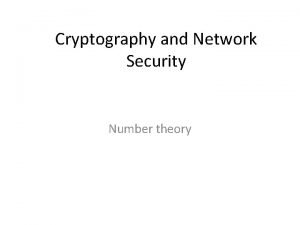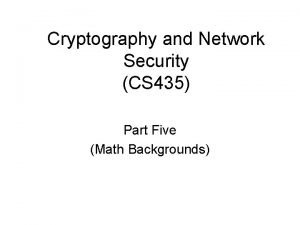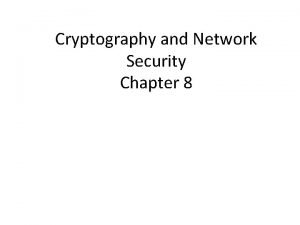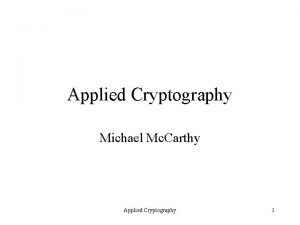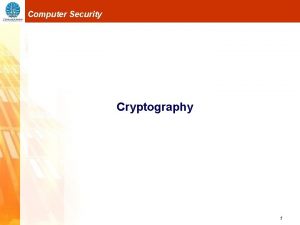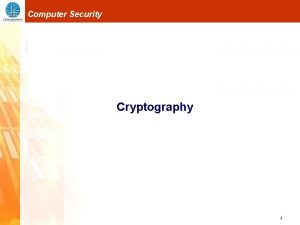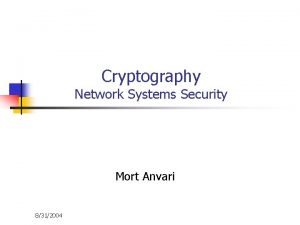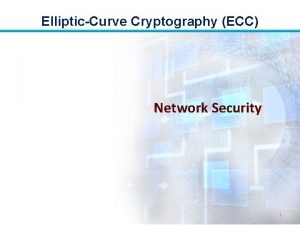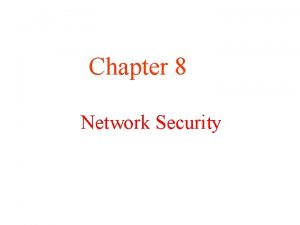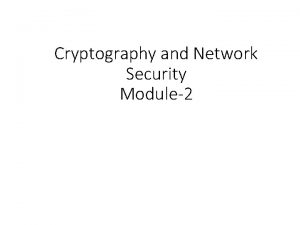Applied Cryptography for Network Security CS 592 University

















- Slides: 17

Applied Cryptography for Network Security CS 592 University of Colorado at Colorado Springs by Jugal Kalita

Background • Information is a difficult term to define • Most valuable information is stored on computers these days • Use of networks and communications links requires measures to protect data during storage and transmission

Aim of Course • Our focus is on Internet Security, i. e, security of information on computers connected to the Internet • Consists of measures to deter, prevent, detect, and correct security violations that involve the transmission of information

Services, Mechanisms, Attacks • Need a systematic way to define security requirements of a system • We consider three aspects of information security: – security attacks – security mechanisms – security services • We consider them in reverse order

Security Service – A security service is something that enhances the security of data processing systems and information transfers of an organization – A security service is intended to counter security attacks – A security service makes use of one or more security mechanisms to provide the service – A security service replicates functions normally associated with physical documents • eg. have signatures, dates; need protection from disclosure, tampering, or destruction; be notarized or witnessed; be recorded or licensed

Security Mechanism • It is a mechanism that is designed to detect, prevent, or recover from a security attack • No single mechanism that can support all functions required • One particular element underlies many of the security mechanisms in use: cryptographic techniques

Security Attack • A security attack is any action that compromises the security of information owned by an organization • Information security is about how to prevent attacks, or failing that, to detect attacks on information-based systems • There a wide range of attacks

OSI Security Architecture • ITU-T (International Telecommunication Union, Telecommunication Standardization Sector) X. 800 Security Architecture for OSI • It provides a systematic way of defining and providing security requirements • It provides a useful, if abstract, overview of concepts we are going to study

Security Services • X. 800 defines a security service as: a service provided by a protocol layer of communicating open systems, which ensures adequate security of the systems or of data transfers • RFC 2828 defines it as: a processing or communication service provided by a system to give a specific kind of protection to system resources • X. 800 categorizes security services into 5 major categories

Security Services (X. 800) • Authentication - assurance that the • • communicating entity is the one claimed Access Control - prevention of the unauthorized use of a resource Data Confidentiality –protection of data from unauthorized disclosure Data Integrity - assurance that data received is as sent by an authorized entity Non-Repudiation - protection against denial by one of the parties in a communication

Security Mechanisms (X. 800) • Specific security mechanisms: – encipherment, digital signatures, access controls, data integrity, authentication exchange, traffic padding, routing control, notarization • Pervasive security mechanisms: – trusted functionality, security labels, event detection, security audit trails, security recovery

Classify Security Attacks as • Passive attacks - eavesdropping on, or monitoring of transmissions to: – obtain message contents, or – monitor traffic flows • Active attacks – modification of data stream to: – masquerade of one entity as some other – replay previous messages – modify messages in transit – denial of service

Model for Network Security

Model for Network Security • Using this model requires us to: – design a suitable algorithm for the security transformation – generate the secret information (keys) used by the algorithm – develop methods to distribute and share the secret information – specify a protocol enabling the principals to use the transformation and secret information for a security service

Model for Network Access Security

Model for Network Access Security • Using this model requires us to: – select appropriate gatekeeper functions to identify users – implement security controls to ensure only authorized users access designated information or resources • Trusted computer systems can be used to implement this model

Summary • Topics Discussed: – Need for Internet security – Security services, mechanisms, attacks – X. 800 standard – models for network (access) security
 Wireless security in cryptography
Wireless security in cryptography Modulo table
Modulo table Security mechanisms in cryptography
Security mechanisms in cryptography Number theory in cryptography and network security
Number theory in cryptography and network security Firewall base layer
Firewall base layer Authentication in cryptography and network security
Authentication in cryptography and network security Three classes of intruders in network security
Three classes of intruders in network security Primitive root in cryptography
Primitive root in cryptography Cryptography and network security 6th edition pdf
Cryptography and network security 6th edition pdf Pearson cryptography and network security
Pearson cryptography and network security Euler's theorem in cryptography and network security
Euler's theorem in cryptography and network security Cryptography and network security 4th edition
Cryptography and network security 4th edition Fermat's theorem in cryptography and network security
Fermat's theorem in cryptography and network security Finite fields in cryptography and network security
Finite fields in cryptography and network security Dsa in network security
Dsa in network security Modular arithmetic in cryptography and network security
Modular arithmetic in cryptography and network security Pgp in cryptography and network security
Pgp in cryptography and network security Euler's theorem in cryptography and network security
Euler's theorem in cryptography and network security












